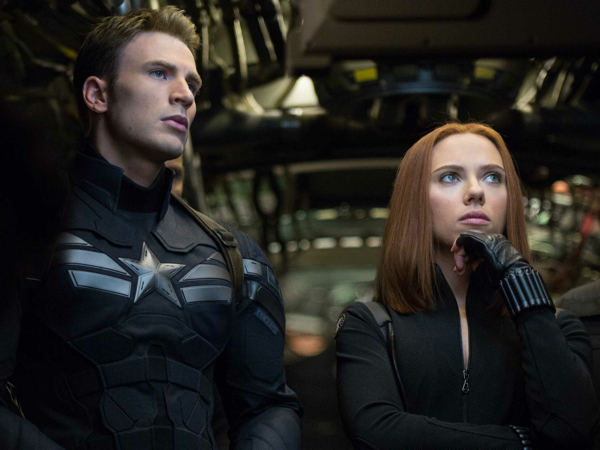Movie review by Greg Carlson
Using Steve Rogers’ status as a man out of time, “Captain America: The Winter Soldier” grafts civil liberties-oriented political critique to its machine-tooled visual effects exoskeleton. Directed by brothers Anthony and Joe Russo, much loved for their Emmy-winning work on the “Arrested Development” pilot and less so for “You, Me and Dupree,” the new installment revels in the muchness that has come to define the Marvel movie model. Chris Evans returns as the Cap, now more attuned to the rhythms of the Internet age but still longing for the WW 2-era purity that continues to inform his moral convictions and unwavering sense of right and wrong.
Captain America’s absolutism clashes with the gray shades of Nick Fury’s (Samuel L. Jackson) post-9/11 model of preemption, but the hero continues to serve S.H.I.E.L.D. in spite of his reservations about the organization’s Big Brother-like dependence on electronic surveillance and espionage, not to mention the group’s failure to be either accountable or transparent. Critics have eagerly made comparisons between “The Winter Soldier” and any number of 1970s political thrillers, inevitable given the presence of “Three Days of the Condor” star Robert Redford as Alexander Pierce, a secretive World Security Council member with ulterior motives.
The borderline naivete guiding Steve begs for the presence of a cynical, wisecracking partner, and screenwriters Christopher Markus and Stephen McFeely supply a good one in Scarlett Johansson’s Natasha “Black Widow” Romanoff. Making her third appearance as the shadowy former KGB operative, Johansson’s character now shares the screen as Captain America’s equal. Post-Cold War cuddles aren’t in the cards – one running gag has Natasha serving as Steve’s matchmaker – but the stark differences between the two (he tries hard to never lie and she struggles to tell the truth) breathe some life into the moments between the punching, kicking, and shooting.
Plot overkill is common currency in the superhero sequel, and “The Winter Soldier” weaves so many different threads it is no wonder Kevin Feige claims to have mapped the Marvel cinematic universe through the year 2028. In addition to dealing with the fate of Nick Fury, the identity of the Winter Soldier (which is no surprise for comic book readers), and introducing Anthony Mackie as the Falcon, the movie crams in references direct or indirect to Quicksilver and Scarlet Witch – called “Miracles” to distinguish the mutants from the Fox-controlled “X-Men” franchise – Iron Man, Crossbones, Stephen Strange, Baron Wolfgang von Strucker, and even Batroc the Leaper. While much of this stuff is incidental to the main course, it all leads to 2015’s “Avengers: Age of Ultron,” Joss Whedon’s highly anticipated juggernaut-to-be.
The serialized, pulpy, soap opera storylines that have sustained comic books for decades might be better suited to the episodic nature of television, but the big budget scale of CG photorealism provides an appealing platform for Marvel’s HYDRA-headed product, especially for viewers who started with the comics. Those who did not might echo Eric Henderson’s argument that the Marvel films are cyclical and “samey,” each one “a warmly welcomed commercial for the next in line.” Of course, nostalgia makes it easier to argue that Joe Simon and Jack Kirby’s medium is superior to the silver screen as mode of delivery for the most satisfying incarnation of the red, white, and blue shield-bearer. One thing is fairly certain: as long as people fantasize about transformative physical prowess and superhuman skill sets, those colorful characters won’t ever be too far away.
